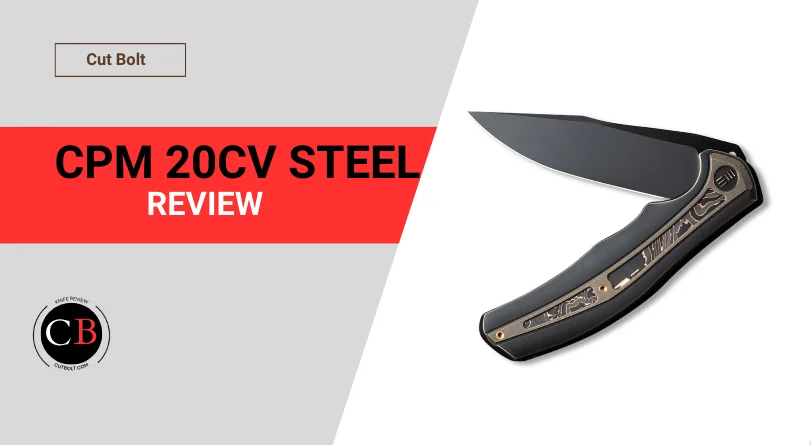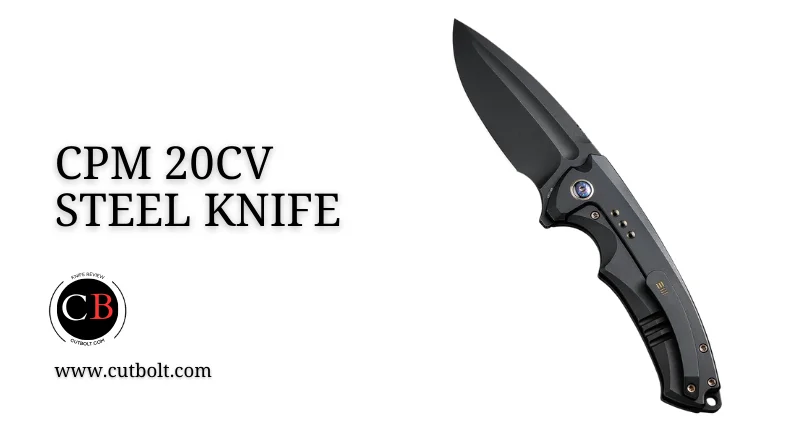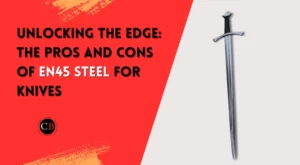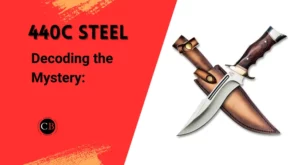Is CPM 20CV Steel Good for Knives? Yes, CPM 20CV is a good steel for knives and it is one of the most popular stainless “super steels” in the world.
CPM 20CV steel is Crucible Industries ‘answer to Bohler’s M390 stainless steel. It also helped Carpenter develop the very similar CTS-204P.
Like the steels mentioned above, CPM 20CV is a powder metallurgy tool steel. The even distribution of carbides within the steel ensures toughness in high-alloy steels.
These facts alone should tell the knife lover a lot.
According to Crucible, CPM 20CV is:
A martensitic stainless steel with a high vanadium carbide content that guarantees exceptional wear resistance.
Table of Contents
What is CPM 20CV steel?
The CPM-20CV is a high-end powder steel from Crucible, USA, known for its exceptional edge retention and impressive corrosion resistance. It is ideal for high-quality pocket knives or EDC knives and outdoor tools. As a product manufactured by Crucible Particle Metallurgy (CPM), it guarantees excellent performance and stability in a wide range of situations.

Chemical composition of CPM 20CV steel
It is commonly found in industrial applications, such as knives in food industry mills. The chemical composition of CPM 20CV, besides iron, is as follows:
| Element | Portion | Effect |
| Chrome | 20.0% | Improves wear resistance, heat resistance and scale resistance. It increases tensile strength because it acts as a carbide former. Use of rust-free or stainless steel, as it increases corrosion resistance from a mass proportion of 12.2%. Reduction in weldability. |
| Carbon | 1.9% | Increasing hardness and tensile strength. In larger quantities, increase in brittleness and reduction in forgeability and weldability. |
| Molybdenum | 1.0% | Improves hardenability, tensile strength and weldability. Reduction in forgeability and ductility. |
| Vanadium | 4.0% | Increasing hardness, increasing wear resistance and improving tempering resistance. |
| Wolfram | 0.6% | Increase in heat strength, tempering resistance and wear resistance at high temperatures up to red heat. |
What is the Hardness of CPM 20CV steel?
The hardness of CPM 20CV steel typically ranges from 58 to 61 HRC (Rockwell Hardness Scale). This level of hardness indicates excellent wear resistance, edge retention, and overall durability, making it well-suited for knife blades.

Why a CPM 20CV steel is an excellent choice for knife blade
When a knife manufacturer is planning a new design, the choice of blade steel plays a critical role in the success or failure of the product. Blade size, blade design, handle materials, aesthetic considerations, handle ergonomics and balance: all of these decisions affect the outcome of the design process. No single decision is probably more important than the choice of steel alloy.
Four comparatively objective criteria and a somewhat subjective performance measure are relevant when knife manufacturers select a steel for a product. Different properties have opposing effects (for example, hardness and grindability), so it is impossible to optimize all the properties of a single steel alloy.
1. Hardness
Hardness indicates how well a steel withstands forces that try to deform it. Since the early 20th century, scientific measurements of material hardness have been based on a series of laboratory tests called Rockwell scales after Hugh Rockwell, co-inventor of the testing apparatus. Of these scales, the C scale is used to represent hardness values for knife steels. The results are presented in numerical values followed by the abbreviation “HRC”.
In alloy hardness testing, a defined force drives a diamond-tipped instrument into a material sample. The depth of the resulting dent reflects the ability of the material to withstand the impact.
A knife blade that permanently bends during use indicates that the steel is not hard enough for that application. In some cases, a designer can compensate for this deficiency by making all or part of the blade thicker. Another way to increase the inherent hardness is to change the way the steel is made. If that is not enough, the only thing that helps is to use a different steel alloy.
Benchmade knives that use CPM 20CV have a hardness of 59 to 61 HRC. Since heat treatment formulations affect the final hardness of a blade steel, another manufacturer may quote different HRC values for the same steel. The hardness for CPM 20CV is slightly higher than the 440C alloy used by Benchmade, which measures 50 to 60 HRC, a longtime popular alloy for knife making.
2. Toughness
Toughness indicates how well a steel can withstand impact or stress without breaking, chipping or cracking. A failure of toughness can be catastrophic if a knife breaks during use (we don’t even want to imagine that). For a knife blade, it is easier to predict wear from abrasion than total failure from a stress spike.
Insufficient toughness can be due to various factors. It can be due to the alloy formula itself, to the way the steel has been heat treated, improper grinding during manufacture, or a variety of combinations of other factors.
Toughness is more difficult to quantify than hardness because no single test provides a standardized measure of the attribute. Typically, toughness testing depends on how far a steel can bend before it breaks or how well the material withstands impact. In many cases, toughness and hardness compete for supremacy, as stiffness, which corresponds to toughness, can come at the expense of the ability to bend without deformation.
CPM 20CV offers toughness that is essentially equivalent to 440C, a proven stainless steel commonly used to make blades.

3. Wear resistance
Wear resistance indicates the ability of a steel to come into contact with and withstand a variety of physical objects and chemical substances without degrading or losing quality. When wear occurs, the causes of wear can come from the objects the user is trying to cut and/or from other influences in the work environment. Wear tests simulate real-world contact between a knife blade and a wear source and document their destructive interaction.
CPM 20CV provides essentially five times the wear resistance of 440C.
4. Corrosion resistance
Corrosion resistance indicates how well a steel resists reaction with oxygen (oxidation) when exposed to moisture or moisture and salt (sea). To increase corrosion resistance, the most common way is to add chromium to the alloy. Although the familiar term “stainless steel” is ultimately a misnomer (as it is overly optimistic), the chromium content nevertheless correlates with the ability to reduce oxidation and provide preventive maintenance to prevent corrosion altogether.
CPM 20CV has a 30% higher corrosion resistance than 440C.
5. Edge retention
The term edge retention attempts to quantify how well and how long a blade stays sharp through use. The Cutlery and Allied Trade Research Association (CATRA) has developed a testing machine to evaluate relative edge retention. In the test apparatus, the knife to be tested is mounted with the cutting edge facing up and a stack of special paper impregnated with 5% silica is lowered onto the blade. The blade moves back and forth, cutting into the paper, and the silica content causes a slight wear on the cutting edge.
The test measures the performance of the blade when it is brand new, as well as the number and depth of cuts the blade can make. This combination of initial cutting performance IPC (“Initial Cutting Performance”), with the number of absolute cards cut TCC (“Total Card Cut”) form the evaluation parameters. The same test instrument can also be used to evaluate sharpening devices.
The CATRA test instrument is part of the testing equipment of many leading knife manufacturers, including Benchmade, Buck Knives and Spyderco.
CPM 20CV achieves a CATRA test value of 180, compared to 440C’s value of 100.
Related: Is S30V steel good for knife making?
Disadvantages of the CPM-20CV for knives
Despite all the advantages that the 20CV has, it is quite expensive. It falls into the premium price range, which may not appeal to everyone. Additionally, while it has excellent edge retention, it can be relatively difficult to re-sharpen once it has lost its edge retention.
Is CPM-20CV rust resistant?
CPM-20CV ranks high in the rust resistance category. The high chromium content (20%) gives this steel excellent corrosion resistance, making it suitable for wet environments.
What is CPM-20CV recognized for?
The 20CV is known to be used primarily in high-quality pocket knives or outdoor tools where high corrosion resistance is required. Many knife enthusiasts appreciate the excellent balance of hardness, edge retention and corrosion resistance.
Conclusion: Is CPM 20CV steel good for knives?
The 20CV is a premium knife steel that offers an excellent balance of hardness, edge retention and corrosion resistance. Although it is a bit more expensive and can be difficult to sharpen once it becomes dull, its performance characteristics make it a top choice for high-quality EDC knives.
A knife made of CPM 20CV steel does just that. It’s tough enough to handle anything you throw at it, and it only takes a few strokes over the leather strap to quickly restore the edge to a fearsome sharpness. CPM 20CV thus takes a top position in many respects, and rightly so.



